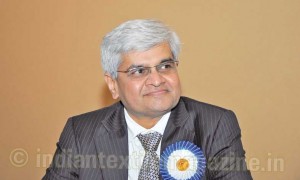
Mr. Sanjiv Lathia, Director, Lathia Group, was elected Chairman of the India-ITME Society for 2013-2015 at its 34th annual general meeting held in Mumbai on September 27.
The Vice Chairmen elected for the term are Mr. Sunil Soni, Director-General, Bureau of Indian Standards, Mr. Prakash K. Bhagwati, Chairman, Textile Machinery Manufacturers’ Association (I) (TMMA), and of Inspiron Engineering Pvt. Ltd., Mr. Diven G. Dembla, President, Indian Textile Accessories & Machinery Mfrs. Association (ITAMMA), and Managing Director, Precision Rubber Industries Pvt. Ltd., Mr. Prem Malik, Chairman, Confederation of Indian Textile Industry (CITI), and Mr. D.R. Mehta, President, the Textile Association (India) (TAI) and ex-Chairman of NTC.
Mr. S. Hari Shankar, Whole-time Director, Lakshmi Card Clothing Mfg. Co. Pvt. Ltd., was elected as Hon. Treasurer of the Society.
Mr. Sanjiv Lathia is currently heading the technical operations of the family-owned Lathia Rubber Mfg. Co. Ltd. Apart from his sharp business acumen, he also has a deep sense of social responsibility and commitment to serve the Society to the extent possible. He has served many associations in multiple roles. To mention a few, he was the President of BIA and also of ITAMMA. He is also closely associated with professional organisations like ASME and ISA.
Continuation of SITP scheme in 12th Plan approved
The Cabinet Committee on Economic Affairs (CCEA) has approved continuation of the scheme for integrated textile parks (SITPs) in the 12th Five-Year Plan and sanction of new projects for utilizing the balance of Rs. 717 crores left in the 12th Plan allocation, after meeting committed liabilities of the sanctioned 61 parks.
CCEA has also approved additional grant of Rs. 10 crores to be given to the existing parks for setting up apparel manufacturing units. A sum of Rs. 50 crores has been allocated for the purpose.
The overall impact and progress of the scheme for integrated textile parks had been positive and had been successful in terms of leveraging private sector investment, employment generation and creation of need-based, product-based world class infrastructure for the industry. With the increasing costs of production in established clusters and heightened emphasis on environmental compliances, there is a growing need for establishment of green field textile parks that would address both these constraints.